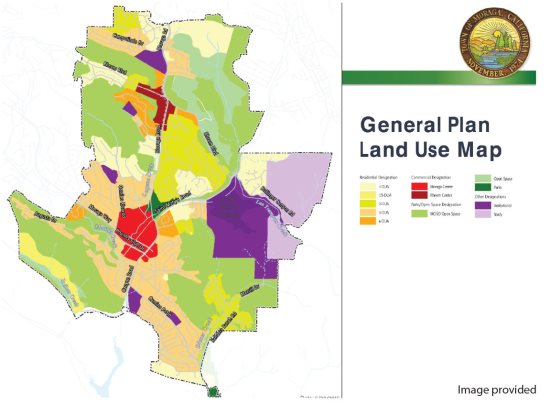
| ||||||
These decisions impact what Moraga will look like in the future and how property owners will be able to develop their properties. The council should approve the final revision of the town's rules, which has been in the making for years, during one of its April meetings.
Planning rules and regulations take years to modify in Moraga and it's rare that this topic stirs residents' passions for more than a few months. The only ones who have had the stamina to follow this long-distance race have been the advocacy group Protect Lamorinda Open Space and large property owners, because the value of their assets is at stake. These voices were indeed the ones offering different perspectives at the March 7 council meeting.
Council members first needed to make a final decision regarding the regulation of building heights so it would not obstruct views of the hills. Previous meetings led to the decision that these views would be observed from a number of specific locations on Moraga scenic corridors (Moraga Road, Moraga Way, Rheem Boulevard, St. Mary's Road, Camino Pablo, Canyon Road, Bollinger Canyon Road, or Donald Drive along the ridgeline of Mulholland Hill). There, an observer needed to be able to see a certain amount of undeveloped ridgeline. The council members had to decide whether 35 percent of the ridgeline should still be visible, or 500 feet from the top or 200 feet from the top of the ridge.
Staff prepared simulations of the different rules for the council members to make a decision. Property owner Stacey LaBarge asked not to add any new cumbersome rule to already protected hills and noted that the height of the observer, whether that person would be on one side of the street or another, changes what is observed. Protect Lamorinda Open Space representative Susan Jones said that her group considered the 35 percent rule a more elegant solution, and the council members agreed.
The elected officials were also asked if the rule should be applied to hillside development only or also to valley floor buildings such as the shopping centers. David Bruzzone, whose family owns the shopping center at the crossing of Moraga Way and Moraga Road and surrounding areas, explained that enforcing such a rule to the valley floor would seriously cripple the economic feasibility of the entire approved Moraga Center Specific Plan.
Council members had different opinions on the topic but chose not to make a decision at the meeting. Instead they agreed that the discussion would be part of the MCSP's revision. Vice Mayor Teresa Onoda and Council Member Kymberleigh Korpus were appointed to an ad-hoc committee that will propose new options for the development of the MCSP, including view shed preservation. Onoda said that in her opinion, larger setbacks and lower building requirements would be necessary to address this question. The two council members have a maximum of nine months to return with ideas.
Most open space areas in Moraga are regulated by MOSO; the non-developed Bollinger area is zoned a "study area," and some land along Rheem Boulevard and Palos Colorados properties are non-MOSO open space. All council members agreed that present regulations limiting development to one unit per 5 acres, or one unit per 10 acres, or one unit per 20 acres as determined by the planning commission should be continued, but that some criteria such as adjacent densities or soil stability should be taken into account.
Finally, the town council unanimously agreed to limit the size of homes on lots over an acre to 5,500 square feet, if the new construction is visible from one of the scenic corridors.
The council decided to set the date of either April 11 or 25 for a final hearing of the new regulation, followed by a vote of the council to adopt it.
Implications of the new rules for the undeveloped 24 acres at the south border of the town
Mark Armstrong, consultant for developer Dobbins Property LLC, which wants to develop the 24 acres between Rancho Laguna Park and Sanders Ranch - a hilly site along Camino Pablo that is county land at this time - said at a previous meeting that if the town's rules precluded development of the land, the developer would not seek incorporation of the property inside Moraga's boundaries and would proceed with more forgiving county regulation. After the meeting, Armstrong indicated that the council's decision to apply Moraga Open Space Ordinance rules to non-MOSO land was acceptable, and that previous height limitation rules on hillsides had been amended to permit planned development on the part of the lot already zoned residential. The process of incorporating the property in the town has not started yet, according to Armstrong.
Reach the reporter at:
